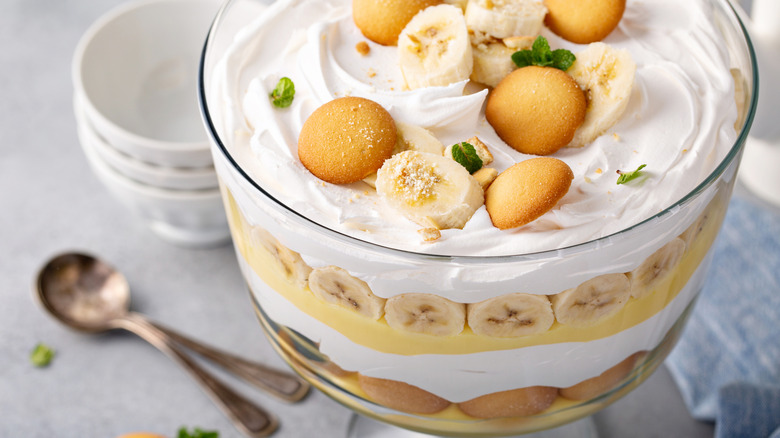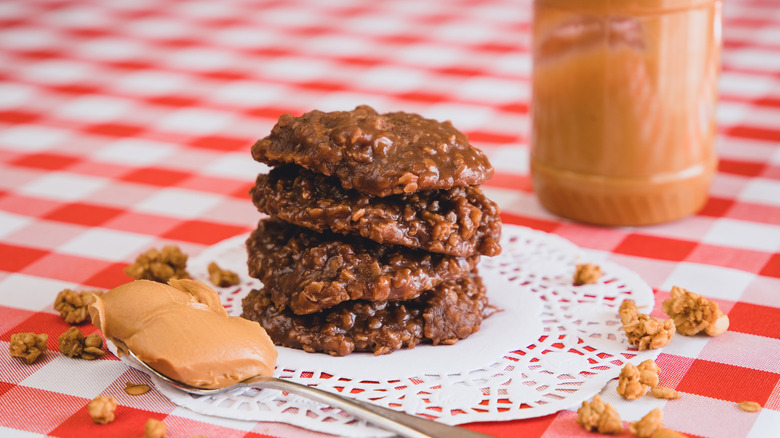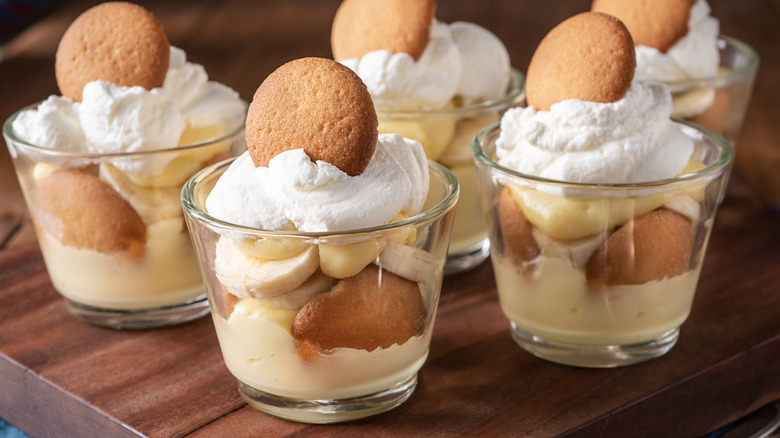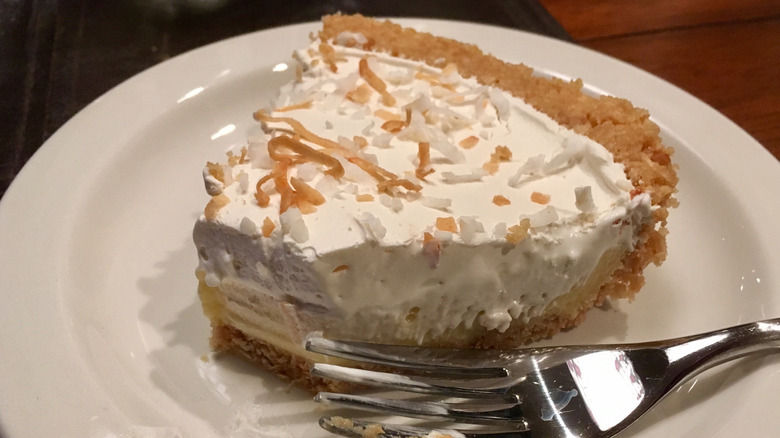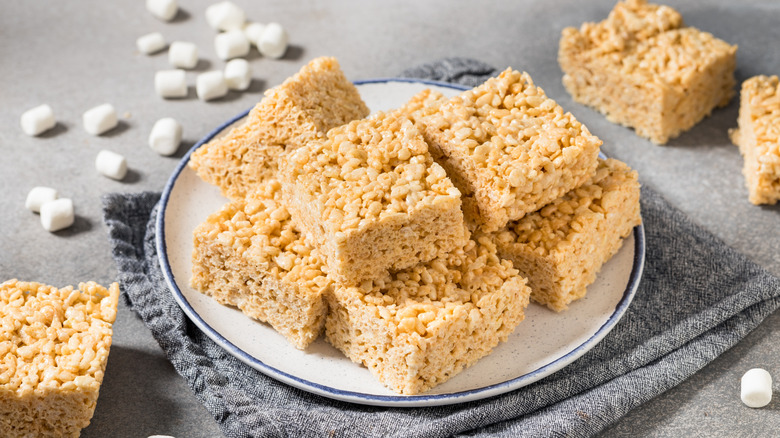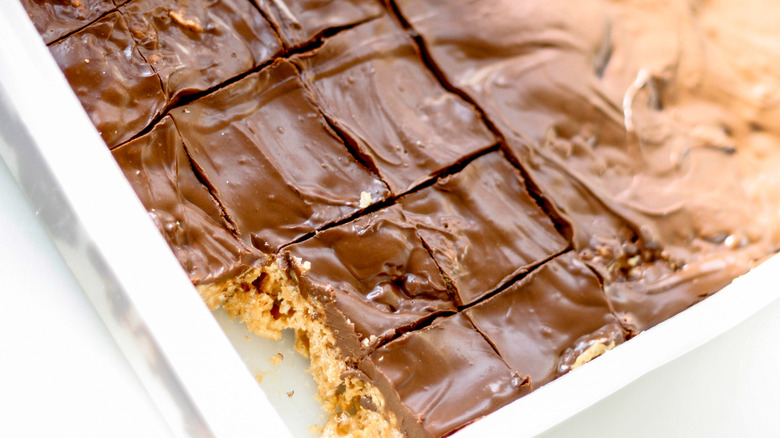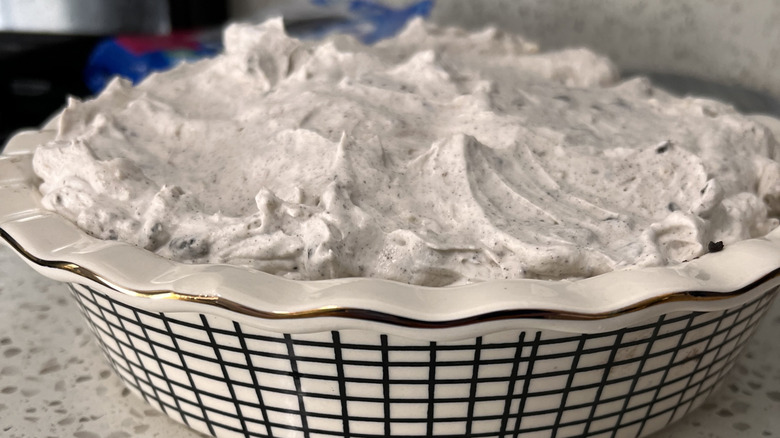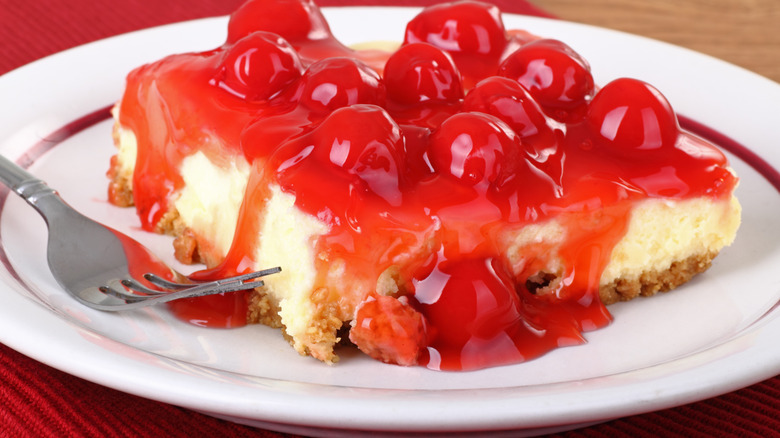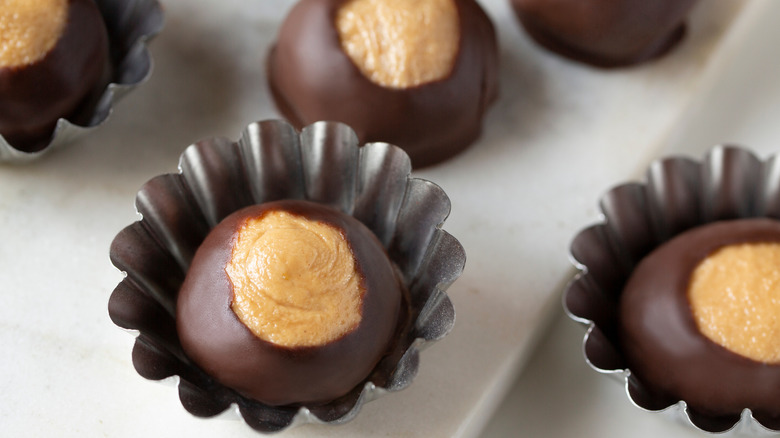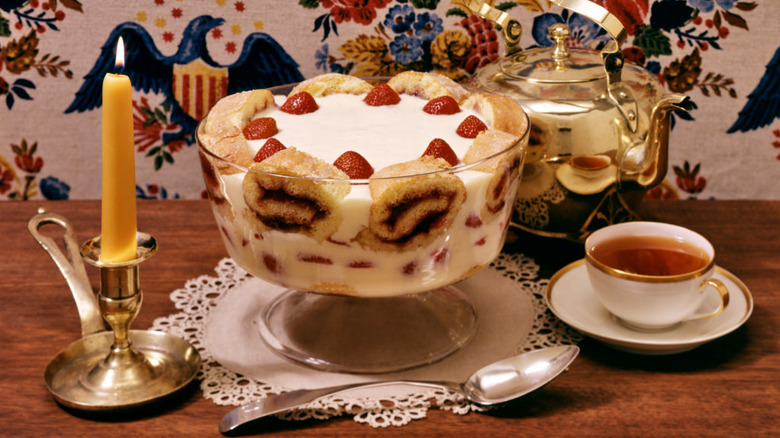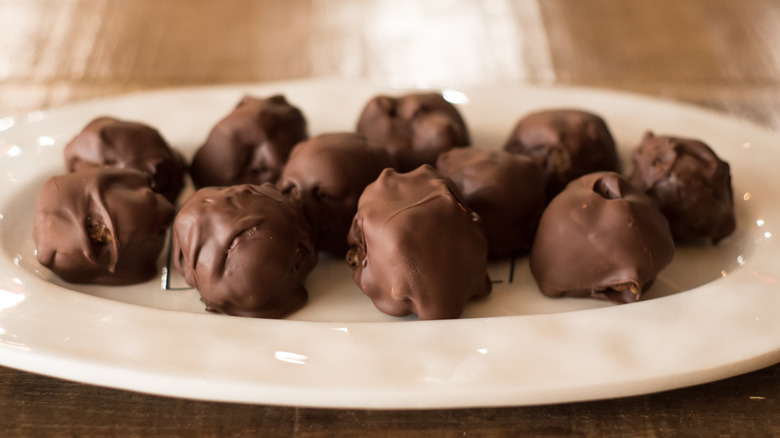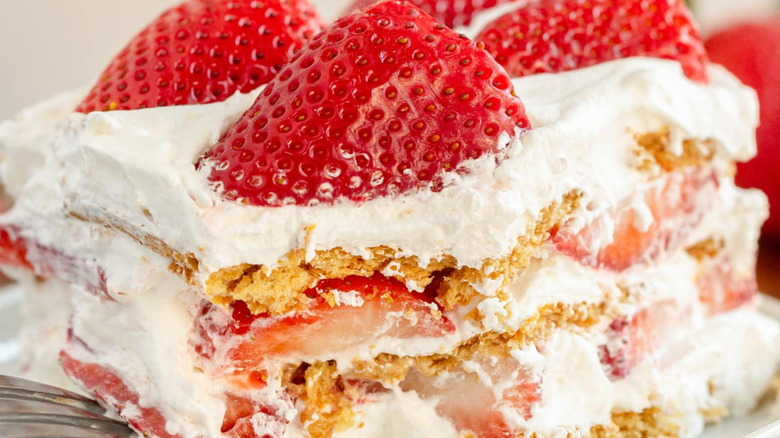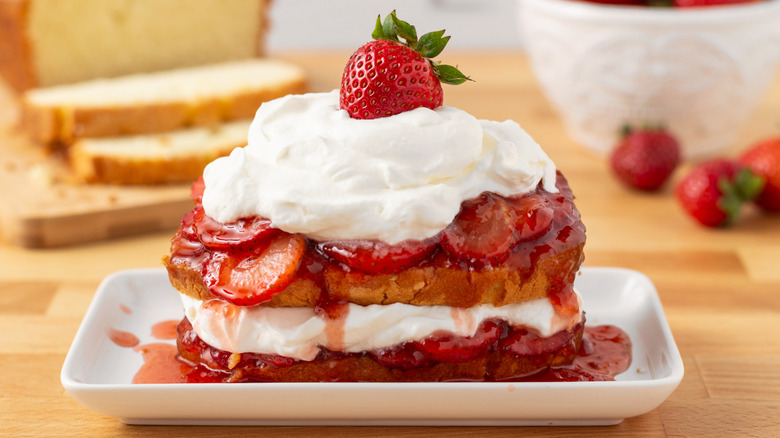14 Old-Fashioned No-Bake Desserts People Still Love Today
There are a lot of recipes and foods from the last hundred years or so that society largely no longer enjoys. Think vintage seafood dishes like tuna Jell-O salad or old-timey summer favorites like tomato aspic. However, some dishes, particularly desserts, have stood the test of time, and we're not just talking about the resurgence of Lambeth cakes in recent years or the simple classics like chocolate chip cookies.
Many old-fashioned no-bake desserts continue to prove popular in large part because of just how easy they are to throw together. Often, you need very little skill in the kitchen to layer a dirt cup or mix up the handful of ingredients necessary for Rice Krispies treats. Plus, while in some cases you might need to use the stove or microwave to melt butter or chocolate, these dishes never require the oven, making them extra-suitable if you don't have one or are trying to avoid heating up the house during the sweltering summer months. In short, it's pretty easy to see why people still love these old-fashioned no-bake desserts today.
1. No-bake cookies
No-bake cookies aren't just any ol' cookie that doesn't require baking. Instead, no-bake cookies are typically made by melting butter on the stovetop, adding milk, cocoa powder, and sugar, and then combining with oats and peanut butter. Then, you drop the batter in spoonfuls on a sheet of parchment paper to let the cookies chill and set. When they're firm, you have a peanut butter-chocolate oatmeal cookie that's a much-requested addition to many a holiday spread.
The history of no-bake cookies goes back to at least the 1930s, when a recipe for a version of no-bake cookies appeared in "Streamlined Cooking" by Irma Rombauer. If you don't recognize Rombauer's name, you'll probably recognize her previous cookbook: "The Joy of Cooking." Rombauer's version of the cookie didn't include peanut butter and, instead, relied on chocolate and breakfast cereal to create what the cookbook described as "a sweet cake or a confection."
2. Banana pudding
Especially in the South, banana pudding is a required dessert at any event, particularly in the summer months. Recipes differ though. Some people use the stove to make a pudding from scratch. Some don't use the stove at all. Some include sour cream. Some use Nilla wafers while others use Biscoff cookies. The end result is always the same, though: layers of sliced banana, whipped cream, vanilla pudding, and cookies, served up in heaping spoonfuls. Let the banana pudding sit in the fridge for a day or two and it's even better, as the flavors meld and the cookies soften.
The very first American recording of banana pudding can be traced back to the late 1800s, when a recipe instructed cooks to combine layers of bananas with custard, whipped cream, and sponge cake. Nilla Wafers were invented around the turn of the century; however, the cookies didn't actually end up in banana pudding until sometime around the 1920s. A few decades after that, you could already find recipes for banana pudding made with vanilla wafers on every Nilla Wafer box.
3. Dirt cups
Whether you call it a dirt cake and spread it in a 9x13-casserole dish, or you make it in individual, smaller servings and call them dirt cups, the gist is the same: chocolate pudding meets crushed chocolate cookies meets gummy worms. The whimsical dessert is a favorite from childhood and many adults still love the nostalgic treat today. Who actually thought to layer these items together in such an admittedly creative way?
While it's difficult to pinpoint a certain person responsible for the no-bake dessert, dirt cup history says it popped up in the Midwest in the 1980s. The earliest printed dirt cup recipe comes from a 1988 newspaper, wherein the dirt cup is called the Kansas dirt cake. The recipe is one that many home cooks still follow today, mixing cream cheese with margarine, sugar, whipped cream, and chocolate pudding, before layering in some crushed Oreos. Not long after this, in the early 1990s, Jell-O began publishing its own dirt cup recipes, utilizing Jell-O instant chocolate pudding.
4. French silk pie
The invention of French silk pie is attributed to baker Betty Cooper, who entered the pie recipe in a 1951 Pillsbury Bake-Off contest. Cooper was a finalist, but she didn't win the contest — that honor went to the Starlight Double-Delight Cake, which gets an extra boost of moisture by incorporating frosting into the recipe's cake batter. Still, while Cooper didn't take home the grand prize, her recipe was inarguably the one to stand the test of time.
Not all French silk pie recipes are entirely no-bake. Some ask you to bake a pie crust, for example, while other recipes use a chocolate crumb-based crust that requires no baking. Otherwise, making the filling simply requires combining butter, sugar, chocolate, and eggs, and pouring the fluffy mixture into your crust before topping it with whipped cream and refrigerating it. Since the recipe calls for raw eggs, just remember to specifically buy pasteurized eggs, which are safer for eating raw. Don't want to go through the trouble of making your own French silk pie? Given the pie's popularity, it's easily found in the freezer section at most grocery stores, ready to thaw and eat.
5. Coconut cream pie
Coconut cream pie is similar to French silk pie in that not all recipes are entirely no-bake, but if you opt for one that uses a no-bake crust, then you'll never need to turn on the oven. This diner favorite can be traced back to a recipe published in 1843, but dessert recipes from even earlier resulted in something similar to a coconut cream pie filling, even if there was no actual pie crust involved.
However, just because a coconut cream pie recipe was published in 1843, that doesn't mean the pie became popular at that point. Have you ever tried to grate your own coconut? It's not an enjoyable process for most, so this pie really only cemented itself within American food culture once desiccated coconut hit grocery store shelves, in the early 1900s. At that point, recipes for the pie used meringue instead of whipped cream, but convenience reigned again once whipped cream became an easier swap for meringue.
6. Rice Krispies treats
Whether you make them from scratch or you simply know that shiny blue foil packaging on sight, Rice Krispies treats are an American food icon. As is the case with many widespread recipes that popped up in the mid-1900s, the first recipe for Rice Krispies treats was published by the brand itself (owned by Kellogg), in an effort to encourage consumers to buy and use more Rice Krispies. There were two different recipes published around the 1930s to 1940s. The first utilized molasses and corn syrup, while the second used marshmallows — and it was that second recipe that stuck.
At that time, Rice Krispies treats were known as simply "marshmallow treats," but they eventually received the name we know today. In 1993, Kellogg's introduced a cereal that channeled the same flavors, and a couple of years later, it began selling packaged Rice Krispies treats, negating the need to make them at home. Since the 1990s, Kellogg's has introduced various takes on the treat, with new flavors and packaging popping up on a regular basis, but the OG still remains a nostalgic no-bake dessert that's not going anywhere any time soon.
7. Scotcheroos
Scotcheroos are similar to Rice Krispies treats, but they come with an extra bit of flair. Additionally, they're more of a regional no-bake dessert, so if you don't instantly recognize the name, it could just be that you're not from the Midwest. As was the case with the original Rice Krispies treat recipe, it's supposed that the original recipe for Scotcheroos appeared on a Rice Krispies box, as the treat requires the Kellogg's breakfast cereal. (Kellogg's also produced a Scotcheroos-flavored version of its Rice Krispies treat around 2000, lending more credence to the idea that the company was behind the dessert invention.)
So what exactly is it? You'll basically make a Rice Krispies treat using the cereal, butterscotch chips, peanut butter, and corn syrup. After the mixture sets and hardens like the traditional treat, you'll go a step further, and spread a topping of melted butterscotch chips and chocolate chips over it all, letting that cool and harden as well. The end result is a more decadent, more grown-up Rice Krispies treat.
8. Oreo pie or torte
Some people just call it an Oreo pie, but others get a little fancy and call it an Oreo torte. Whatever you call it, it's delicious, simple, cheap, and convenient. While Oreos have been around for a while, the Oreo pie isn't quite a century old yet. With a somewhat murky history, the Oreo pie or torte relies on multiple convenience products that ensure it couldn't have evolved until at least Cool Whip and instant chocolate pudding were readily available.
Though instant pudding has been around since the 1910s, invented approximately at the same time as the Oreo, Cool Whip was only created in 1966. Regardless, whoever first decided to crush up some Oreos, press them into a pan, and then fill that Oreo crust with cream cheese, sugar, pudding, and Cool Whip, was a genius. The Oreo pie has remained a favorite no-bake pie that many fondly recall from their childhoods and still enjoy today.
9. Cherry delight or cherry yum yum
Cherry delight and cherry yum yum are the same dessert, with a different name depending on where you are in the country. Cherry yum yum seems to be the preferred moniker in the South. The origins aren't clear, but this no-bake dessert finds its way to potlucks and family holiday tables, and everyone knows someone who can make an absolutely superior version of the dessert, even if it's so simple that anyone could make it.
Like so many other no-bake dessert recipes, this one relies on convenient ingredients. Essentially, the recipe comes down to a crushed graham cracker crust, a cream cheese and whipped cream filling, and a can of cherry pie filling on top. There are some variations; for example, some recipes may use Dream Whip rather than Cool Whip, and some may use a baked crust instead of a graham cracker crust. Whatever the slight differences may be, the final product is a bit like an easier, cheaper version of a cherry-topped piece of New York-style cheesecake.
10. Buckeyes
A Midwest treat with Ohio roots, the buckeye looks like ... well, a buckeye. The peanut butter and chocolate candy requires no baking but easily claims a top spot among the Christmas cookies at many a holiday party. The story goes that Gail Tabor invented the candy in the 1960s when attempting to make chocolate-covered peanut butter balls. The chocolate didn't cover the peanut butter balls all the way, and the result was something that looked like the nut that falls from the Ohio buckeye tree. Word of this delicious, no-bake treat spread and now you can find buckeyes for sale in quite a few specialty foods stores throughout the region.
The filling is a mixture of mostly sugar, peanut butter, and butter, and the exterior coating is just chocolate. If you use a microwave to melt the butter and chocolate, you won't even need a stove to make this no-bake treat.
11. Trifles
A lot of old-fashioned, no-bake desserts on this list only go so far back as the last century or so, but that's not the case for trifles. Trifles are a British concoction, emerging in the 1700s. Much like today, trifles were a way to cobble together whatever you had on hand, in order to improve on the components. Stale cake received new life via an alcohol bath, and then was layered with a pick-your-own-adventure array of fruit and other moisture-enhancing ingredients, like custards or jellies. The Brits brought the trifle to the States and the colonies ran with it. Now, a trifle can be any layered dessert alternating a bready or cakey ingredient (like brownies, cookies, cake, etc.), some sort of pudding layer, and whipped cream.
Don't feel like you've ever really eaten a trifle, even if you're familiar with the concept? A handful of desserts go by other names, even though they're a trifle by definition. For example, if you've ever eaten a Death by Chocolate dessert, that's a trifle. Banana pudding? Could technically be considered a trifle.
12. Bourbon balls
Bourbon balls are buckeyes' misbehaving Southern cousin. Invented by Ruth Hanly Booe, of Frankfort, Kentucky, the recipe was an iteration of another that Ruth had used previously, when she and fellow schoolteacher Rebecca Gooch founded Rebecca Ruth candies. After Rebecca sold her part of the business to Ruth and Prohibition ended, Ruth gave their original chocolate candy recipe a bourbon boost and the rest is history. The candy company still exists today.
If you've never had a bourbon ball, it's basically just bourbon, pecans, butter, and sugar, covered in a chocolate coating. Because you never cook any of the ingredients beyond melting the butter and chocolate, the bourbon balls remain boozy. You need at least a slight taste for bourbon to enjoy this no-bake treat, and once you do, you'll quickly see why bourbon balls retain their popularity in Kentucky and beyond. They're especially popular around the holidays, when the candy is served at get-togethers and given as a gift.
13. Icebox cakes
Like the very similar trifle, icebox cakes come in many forms and can be made with whatever you have on hand. They're versatile and diverse, and they're also pretty historic. The 18th-century French dessert known as the Charlotte was an icebox cake predecessor, featuring molded layers of custard and cookies. However, to make a true icebox cake, you need an icebox, aka, a refrigerator, so the cake's final form was delayed a bit.
Some of the first fridges came with recipe booklets that included fridge-reliant recipes such as those for icebox cakes. However, it was Nabisco that really popularized the no-bake dessert, when the brand printed a recipe on its cookie boxes for an icebox cake that required minimal ingredients and minimal work. The original recipe's simplicity cannot be understated. It was just whipped cream and chocolate wafer cookies, all layered together in a horizontal row, before the log-like cake was covered in more whipped cream. Today, you can find icebox cakes that combine graham crackers and berries, Oreos and whipped cream, and a range of other ingredients, but the original Nabisco recipe still retains a fanbase.
14. Strawberry shortcake
Another as-simple-as-it-gets no-bake dessert, strawberry shortcake almost shouldn't feel like a treat — it's too simple. While you could go through the effort of making the ingredients from scratch, at the end of the day, if you want to go the no-bake route, all you do is pick up some shortcake or sponge cake (the former is more popular in the south while the latter is more popular in the north), fresh strawberries or strawberry pie filling, and whipped cream from the store. Strawberries go on the cake. Whipped cream goes on the strawberries. Voila. And yet this utterly easy dessert has become such a classic that we even have a cartoon character named after it.
The very first strawberry shortcakes weren't quite so convenient, admittedly. The first recipe appeared in an 1847 cookbook and required home cooks to make both the cake and icing. However, the recipe changed over time until today, you don't even need a recipe at all.
